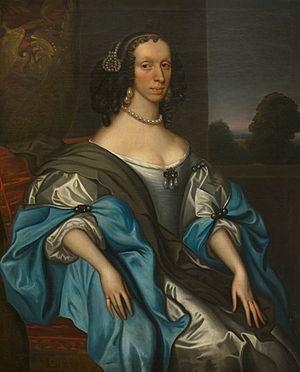Anne Hamilton, 3rd Duchess of Hamilton facts for kids
Quick facts for kids
The Duchess of Hamilton
|
|
|---|---|

Portrait by David Scougall
|
|
| Duchess of Hamilton | |
| Tenure | 1651–1698 |
| Predecessor | William Hamilton |
| Successor | James Hamilton |
| Other titles |
|
| Born | 6 January 1631 Palace of Whitehall, London, England |
| Died | 17 October 1716 (aged 85) Hamilton, South Lanarkshire, Scotland |
| Buried | Bent Cemetery, Hamilton |
| Noble family | House of Hamilton |
| Spouse(s) | William Douglas, 1st Earl of Selkirk |
| Issue |
|
| Father | James Hamilton, 1st Duke of Hamilton |
| Mother | Lady Mary Feilding |
Anne Hamilton, 3rd Duchess of Hamilton (born January 6, 1632 – died October 17, 1716) was an important Scottish noblewoman. She was known for her strong leadership and for managing her family's lands.
Anne was born in London at the Palace of Whitehall. Her mother, Lady Mary Feilding, worked for Queen Henrietta Maria of France. Anne's father was James Hamilton, 1st Duke of Hamilton. He was a powerful Scottish general and a leading noble.
Becoming the Duchess
Anne's father, the 1st Duke, died in 1649 during a time of war. His brother, William, then became the Duke. However, William was badly hurt in the Battle of Worcester in 1651 and later died.
Before he died, William decided that Lady Anne would be his heir. This was unusual because he had his own daughters. But his only son had died young. So, Anne became the Duchess of Hamilton.
She also gained other important titles. These included Marchioness of Clydesdale and Countess of Arran. This happened because of a special rule. It said that if her uncle had no sons, the dukedom would pass to the 1st Duke's eldest daughter.
Anne's family had a connection to the Scottish throne. She was related to James II of Scotland. Her family line could even claim the throne if the House of Stuart family had no heirs.
Family Life and Children
In 1656, Anne married William Douglas, 1st Earl of Selkirk. He was a younger son of a powerful family. After their marriage, William was made Duke of Hamilton for his lifetime. He also took the Hamilton family name.
Between 1657 and 1673, Anne and William had 13 children:
- Lady Mary Hamilton (1657–1666)
- James Hamilton, 4th Duke of Hamilton (1658–1712)
- Lord William Hamilton (1659–1681)
- Lady Anna Hamilton (1661–1663)
- Lady Catherine Hamilton (1662–1707)
- Lord Charles Hamilton (1664–1739)
- Lord John Hamilton (1665–1744)
- Lord George Hamilton (1666–1737)
- Lady Susan Hamilton
- Lady Margaret Hamilton (1668–1731)
- Lady Anna Hamilton (born 1669), died as a baby
- Lord Basil Hamilton (1671–1701)
- Lord Archibald Hamilton (1673–1754)
In 1698, Duchess Anne gave up her titles to King William. The King then gave them to her eldest son, James. This was likely because Anne and her husband had been loyal to the King.
Duchess Anne passed away in Hamilton on October 17, 1716. She was buried there in Bent Cemetery.
Building and Legacy
After her marriage, the Duchess and her husband started building a grand home. This would later become Hamilton Palace. It was built on the site of an older family home. The Hamilton family had lived in this area since the 1300s.
In 1684, Anne hired an architect named James Smith. She asked him to redesign the existing buildings. They made the house much larger and shaped like a "U".
Today, Hamilton Palace no longer stands. The land where it was built is now part of Strathclyde Country Park. It was given to the nation in 1973.
Duchess Anne also helped build a new school. This was for the Grammar School of Hamilton. Her great-grandfather had first started the school in 1588. In 1714, Anne gave the new school building to the town. The school used this building until 1848.
The building Anne built was taken down in 1932. But a plaque remembers the spot. The Hamilton family continued to support the school for many years.

